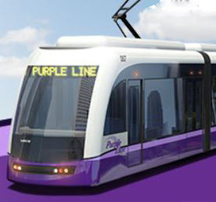Defense of Rail by Paul Weyrich
The Bush administration is right about most things, but they are dead wrong about one of them -- urban mass transit. I am known for my work in cultural conservatism, for putting grass roots coalitions together and for efforts to liberate the former Soviet empire. If truth be known, my real expertise is in urban mass transit. I helped to organize a commuter group aimed at saving a threatened rail line in the Midwest and served as Washington correspondent for a transit publication. I did transportation appropriations work in the U.S. Senate for six years, published a rail transit magazine for eight years, served on the Amtrak board for six years and served as Vice Chairman of the Amtrak Reform Council for five years. With my colleague Bill Lind, I have co-authored six monographs on urban transit in co-operation with the American Public Transit Association. So when I take issue with an Administration policy it is because I have some background in doing so.
The Bush administration is anti-rail transit and is pushing something called "bus rapid transit". What is bus rapid transit? Whatever the Bush Administration says it is. So in one case, it means busses operating on a completely separate right-of-way reserved just for transit vehicles; in other cases it means buses running in carpool lanes that can often get just as congested as regular highway lanes; in still another case it means buses running on city streets with lanes reserved for buses during certain hours. There are other versions as well. Supposedly, bus rapid transit is a substitute for light rail. The Administration says that bus rapid transit is so much cheaper to build and achieves speeds comparable to light rail. That assertion is questionable, but even if true, has one major flaw. People don't want to ride buses!
Light rail lines, on the other hand, although more expensive to construct, have almost always attracted more passengers than projected... Many of those users are not transit dependent but are leaving their automobiles behind for fast, reliable trains. That will happen with sleek, modern trains. It won't happen with buses. No matter how much the seats are made more comfortable, a bus is still a bus. The Administration says buses are superior because they are more flexible. Yet that is the weakness of a bus system. Riders aren't sure if the bus is really coming and moreover they aren't sure a bus rapid transit system will be there next year. A fixed rail system is reliable and will be there for decades to come.
Bus rapid transit may be cheaper to build, but it is not cheaper to operate. Light rail trains in San Diego, Sacramento and other places regularly run four car trains in rush hour. These are long, articulated cars, so we are looking at the equivalent of a six-car train. Los Angeles just lengthened all of its platforms on the Blue Line to Long Beach in order to accommodate three articulated cars that they run during morning and evening rush hours. That line, by the way, was the last route of the once great Pacific Electric System to be abandoned. It carried 12,000 people a day in its last full year of operation 1960. Substitute bus service carried only about 8,000 a day. Today, the fast, air-conditioned and reliable trains carry about 73,000 each weekday. Thousands have left their cars to ride light rail. Since these trains rely on ticket machines with random inspections for operations, there is only a single operator per train. Each bus would require a driver. Even though buses would attract a small percentage of passengers of what light rail would get, it would require dozens and dozens and dozens of additional operators. Labor is well over 50% of the cost of operating any transit system.
Light rail is a solid means of mass transit. It can operate in the street, in a median of highways, in a subway, on an elevated structure and so on. We had excellent systems all over America. Most were abandoned in favor of buses, but beginning in San Diego in 1981, light rail has made a remarkable comeback. We were down to seven cities with light rail lines in the 1970's. Now 26 cities have some sort of light rail lines. There are 19 more looking at light rail seriously. The Administration has told most of these cities that they can forget rail. The Administration has implied that if cities want federal money, they should plan for bus rapid transit.
Local officials are telling the Administration that they don't want buses. Some cities are planning to go it alone with state and local funds providing the revenue necessary to construct rail.
Bus rapid transit is a fad. It won't last. The Administration has been sold a bill of goods, no doubt by highway interests that have always opposed rail from the very beginning of federal mass transit involvement in 1965. It is hard to get policy makers to ever admit they are wrong. It would behoove the Federal Transit Administration officials to reverse themselves. There would be dividends for doing so. Ronald Reagan, who was the prototype conservative President for modern times, was pro-rail. Some pundits call George W. Bush, Reagan Junior. He ought to emulate Reagan in this arena.

